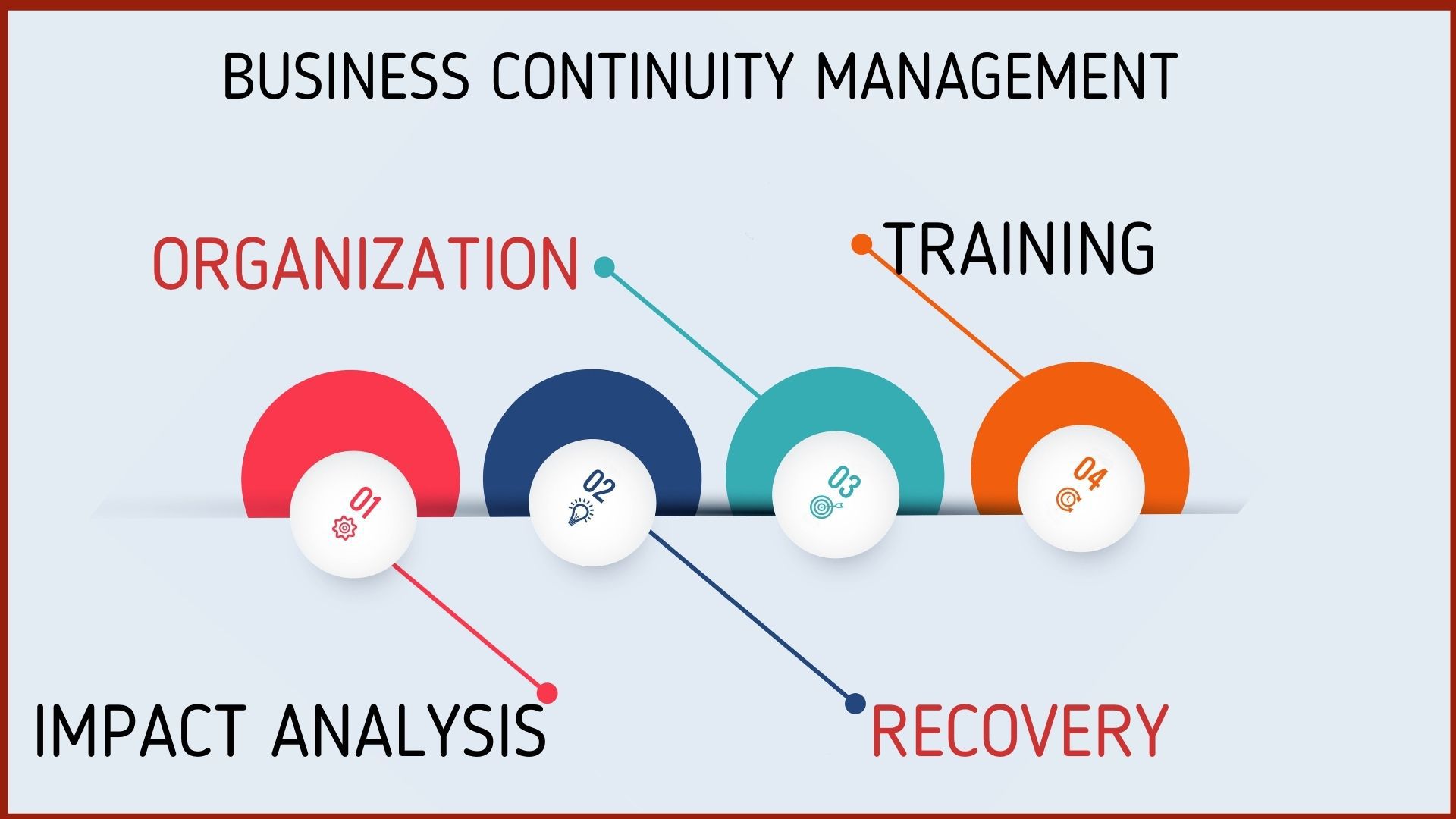Business continuity management (BCM) revolves around strategies, plans, and actions for crisis management, business-recovery planning, and IT disaster recovery.
BCM identifies potential threats to an organization and safeguards the interests of different stakeholders and business-reputation. It helps businesses to survive in difficult times. A business organization needs to continue functioning even during tough times.
By difficult times, what is meant here is a pandemic, a natural disaster, or anything that might disrupt business operations.
All in all, business continuity is an organization’s ability to carry on in the wake of a disaster and after it. Recovering from a disaster without being affected is the basis of business continuity.
Every organization must have a risk management strategy in place so that essential services can function. It is also necessary that operations can be re-established smoothly without any time loss. This post will uncover what Business Continuity Management is and how you can do it effectively.
Table of Contents
What is Business Continuity Management?
How to manage business continuity in the event of a cyber attack, natural disaster, unavailability of employees, or any other such unforeseen situations?
How business continuity has to be achieved is what makes up for business continuity management. How to equip an organization to continue to function even when conditions are not favorable is the focus of business continuity management.
The recent pandemic has made everyone sit up and think about business continuity management and risk mitigation in times like this. Companies are now taking business continuity management more seriously.
Business Continuity Management effectively maintains normal business operations at the time of a disaster with no or minimal disruptions.
Thinking and planning for such situations have not been given due importance until now.
These are things that most people imagine to be highly unlikely occurrences, and putting a plan in place for such eventualities was thought of as a waste of resources.
Why is Business Continuity Management important?
There are various reasons for having a business continuity management in place. Among other things, it can help your significant and immediate recovery from:
- Business Failure
- Dangerous Emergencies Resulting In Grievous Injury or Death
- Income Loss and Loss of Net Worth
- Response to a Negative Brand Impact Crisis
- Incapacity to Operate Due to Application Shutdown or Malfunction
There are also a few other reasons that warrant the importance of business continuity management in an organization. They are:
- Legal and Regulatory Compliance
- Customer Demand for Potential Vendors to Demonstrate that they have a Business Continuity Management Programs in place
- Business Continuity Management improves the ability to provide risk transfer information
- Business Continuity Management also helps companies to protect their reputation in adverse circumstances.
2 Phases of Business Continuity Management
What business continuity management does is to put together a strategy to help businesses continue in difficult and unforeseen situations.
There are two phases for business continuity management called-
- Business continuity planning
- Business continuity framework
Together, they make up business continuity management.
Business continuity planning chalks out potential risks and spots a recovery mechanism for the organization in case of an eventuality.
The business continuity framework draws up a step by step response process for the identified risk and corresponding recovery process.
Elements of a Business Continuity Management
A good business continuity plan should include:
1. Impact Analysis
A study of what is impacted and how much of an impact the disruption can create.
Different operations can be disrupted, and each should be a separate case study. – And impact analysis analyzes all such impacts.
2. Recovery
How to effectively overcome the disruptive situation?
The steps that should be taken concerning each kind of disruption identified in the earlier step.
You should also know how to manage the disruption without a significant loss of business.
3. Organization
A team responsible for continuity management to oversee the smooth transition of operations during disruption and soon after the disruption should be created.
4. Training
They are making sure that the said team is adequately trained to handle these challenging situations.
They should also know the plans and strategies well enough to carry out the plan without further delay when the situation demands.
7 Steps involved in making a Business Continuity Management Plan
1. Risk Assessment
In this step, you conduct a thorough study of your industry and the threats you may have to face in different emergencies.
Each emergency might have a different severity level and must be ranked accordingly. Each risk should be analyzed and backed with data, and all the minor details accounted for.
2. Impact Analysis
Once the risks have been identified, the areas that each type of risk will impact should be recognized.
It should be considered, along with the time taken for getting the operations back on track for each area that is affected, should be identified.
Each process’s criticality should be the base for deciding what the operations need to be operational right away and what can wait.
3. Metrics
Measurement and comparison of the risks you have and the risks that will remain once your framework is in place is the next step.
Detailed analyses will help but wasting time collecting metrics that do not contribute to the recovery process must be avoided.
4. Budget
It is an essential step in the business continuity plan. There should be a stipulated amount that is kept aside for such situations.
Focusing on the critical areas that need to be operational will help cut unnecessary costs in difficult times. Do not allocate a contingency budget for getting not so critical operations up and running immediately.
The criticality of each operation and the corresponding budget should be decided after careful deliberation.
5. Recovery
Finally, when everything is in place, it is time to draw a framework for how everything should be executed smoothly in a disruptive situation.
A framework is critical as the rules should be set as the situation only allows for so much time to follow guidelines.
Therefore, the guidelines or a framework should be in place, and the team responsible for business continuity management should be trained and well aware of the set of guidelines.
6. Testing Frameworks
The frameworks, once finalized, should be tested to see if they can be executed without glitches.
Conducting realistic exercises, drills, and walkthroughs are a way to understand the operability of these frameworks. It is a must that these frameworks are functional before they are officially adopted.
7. Review and Improvements
Any flaws found during testing should be rectified or a new framework adopted in the framework being non-functional. Suggestions for improvement can also be implemented before you finally decide on the framework.
How to embed BCM in Business Activities?
For embedding Business Continuity Management in your business activities, you need to-
- Identify and analyze business continuity risks
- Assess the impact of the disruption of business-critical processes
- Formulate a BCM Strategy for the recovery of operations
- Timely and effective crisis management
How to Develop BCM Culture in your Organization?
Different steps that help in developing the culture of BCM in an organization are-
- Leadership from management at all levels
- Assignment of BCM responsibilities
- BCM Skills training
- BCM Awareness raising
- Exercising BC Plans and Crisis Management Plans
- Ensuring that Business Continuity requirements are comprised of strategic and investment decision-making
Key Purpose of a Good Business Continuity Management Plan
- Protecting staff and shareholder interests
- Continuing operations/services and minimizing the impact of disruption
- Adhering to Legal and Regulatory requirements
- Maintaining the company’s reputation
- Governance and Business alignment
- Continuity Strategy and plan documentation
Final Thoughts
Today’s pandemic situation has forced companies worldwide to sit up and note the vitality of how a company handles business continuity management.
The complacent view of business continuity management has suddenly changed, and business continuity management has become the need of the hour for most of the businesses across the globe today.
BCM incorporates business continuity (BC), crisis management (CM), crisis communication (CC), and disaster recovery (DR), which are crucial for the successful continuation of business even after a disaster.
How important do you consider BCM for an organization? Share your views with us in the comment section below.
Liked this post? Check out the complete series on Business


